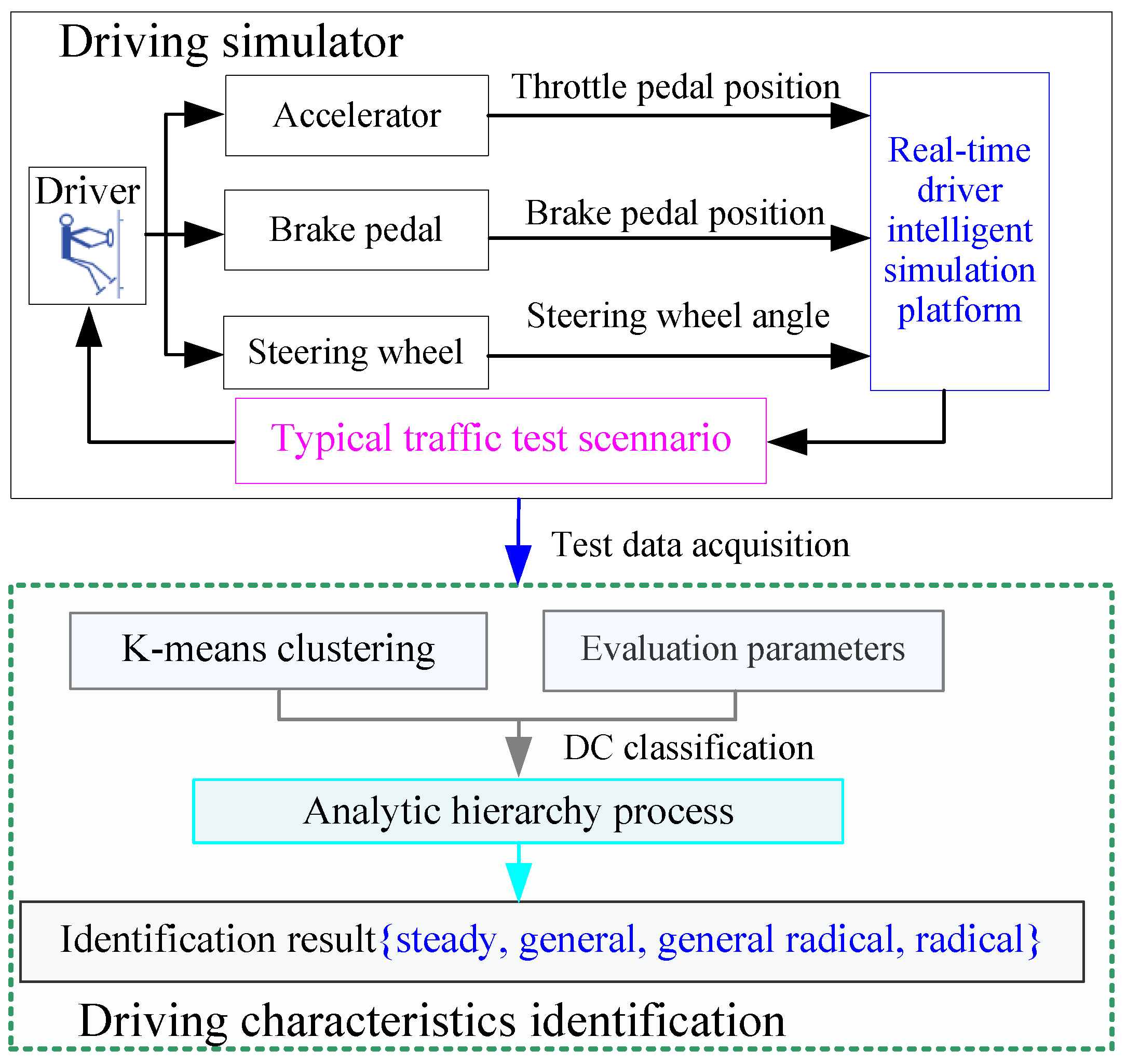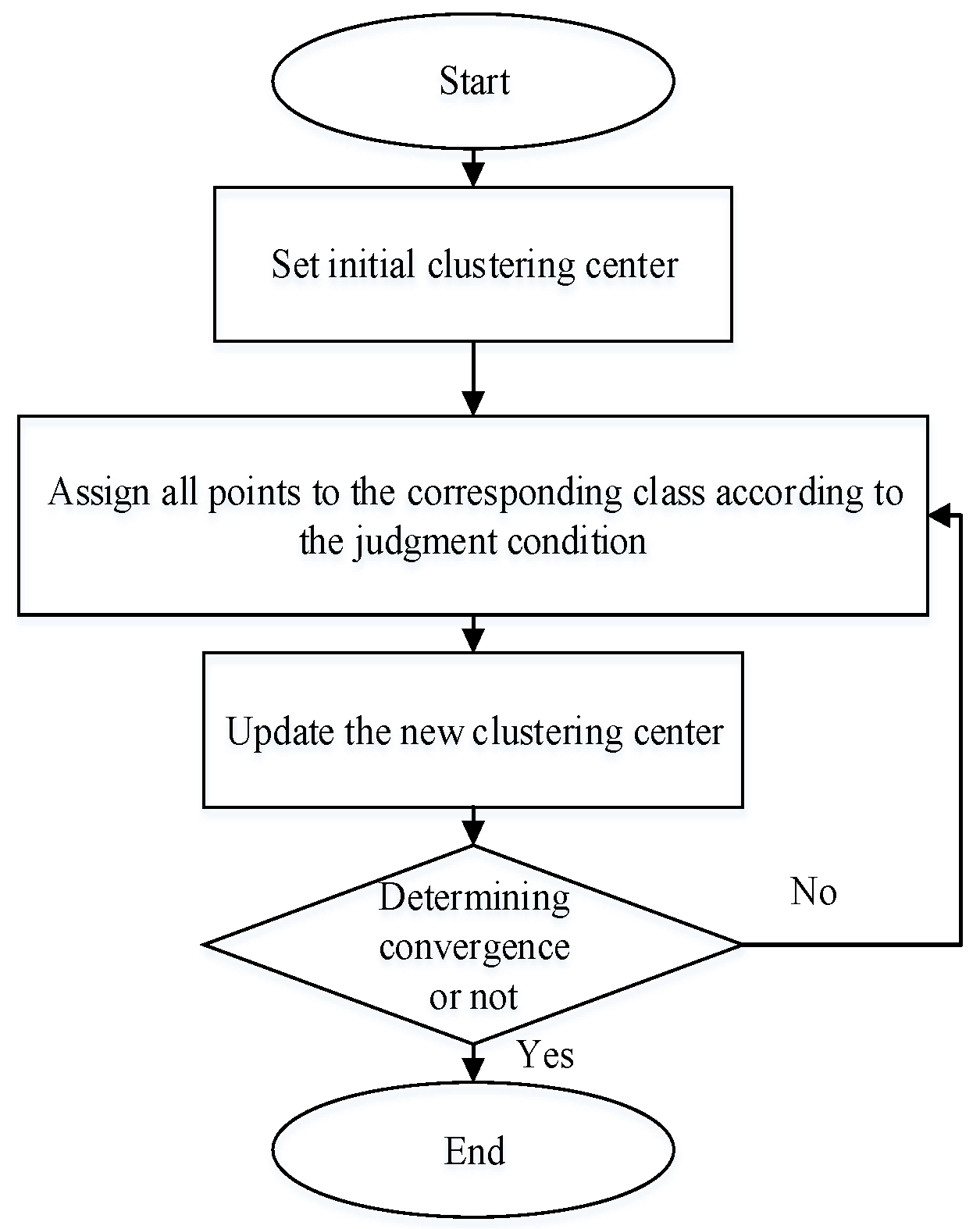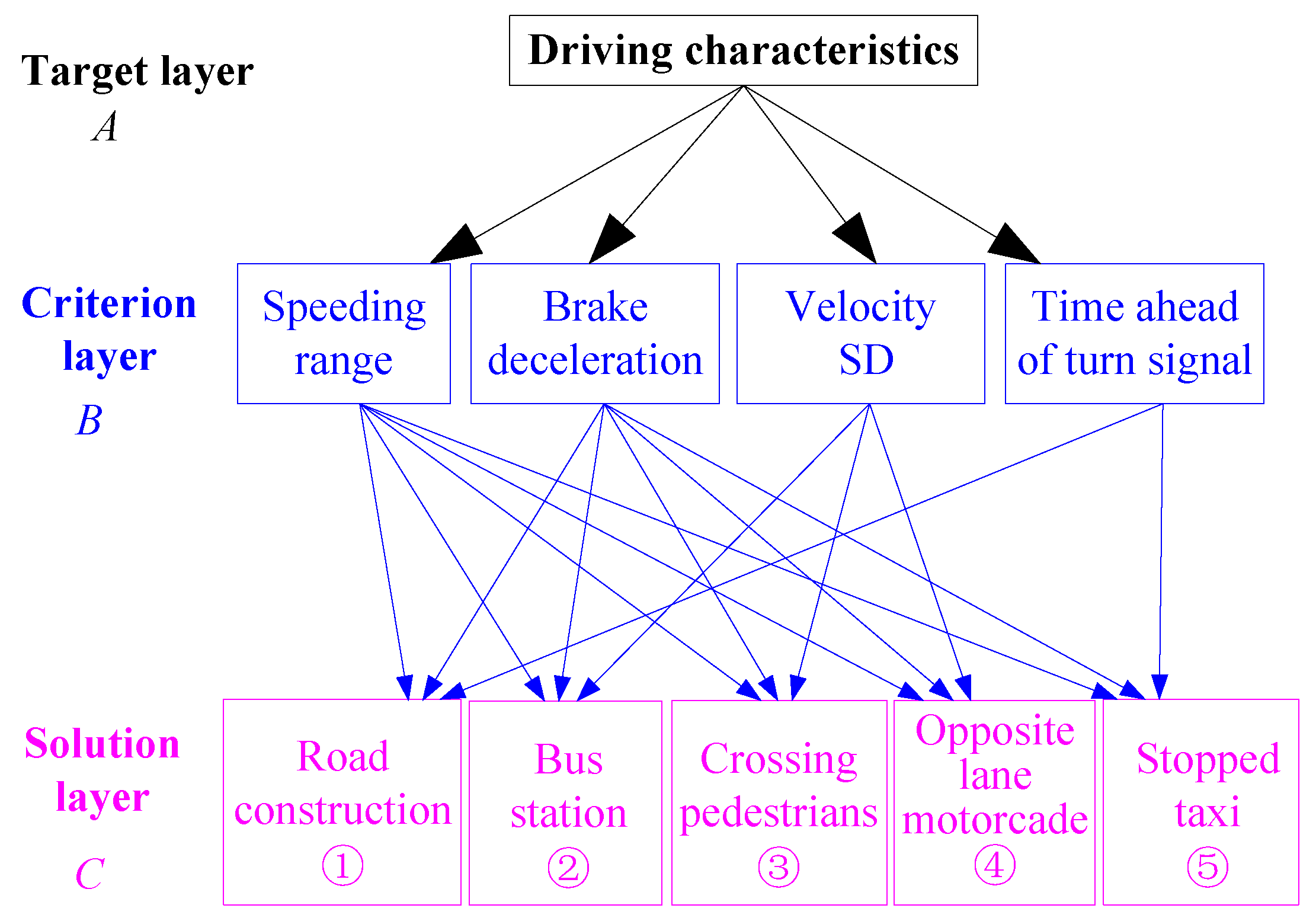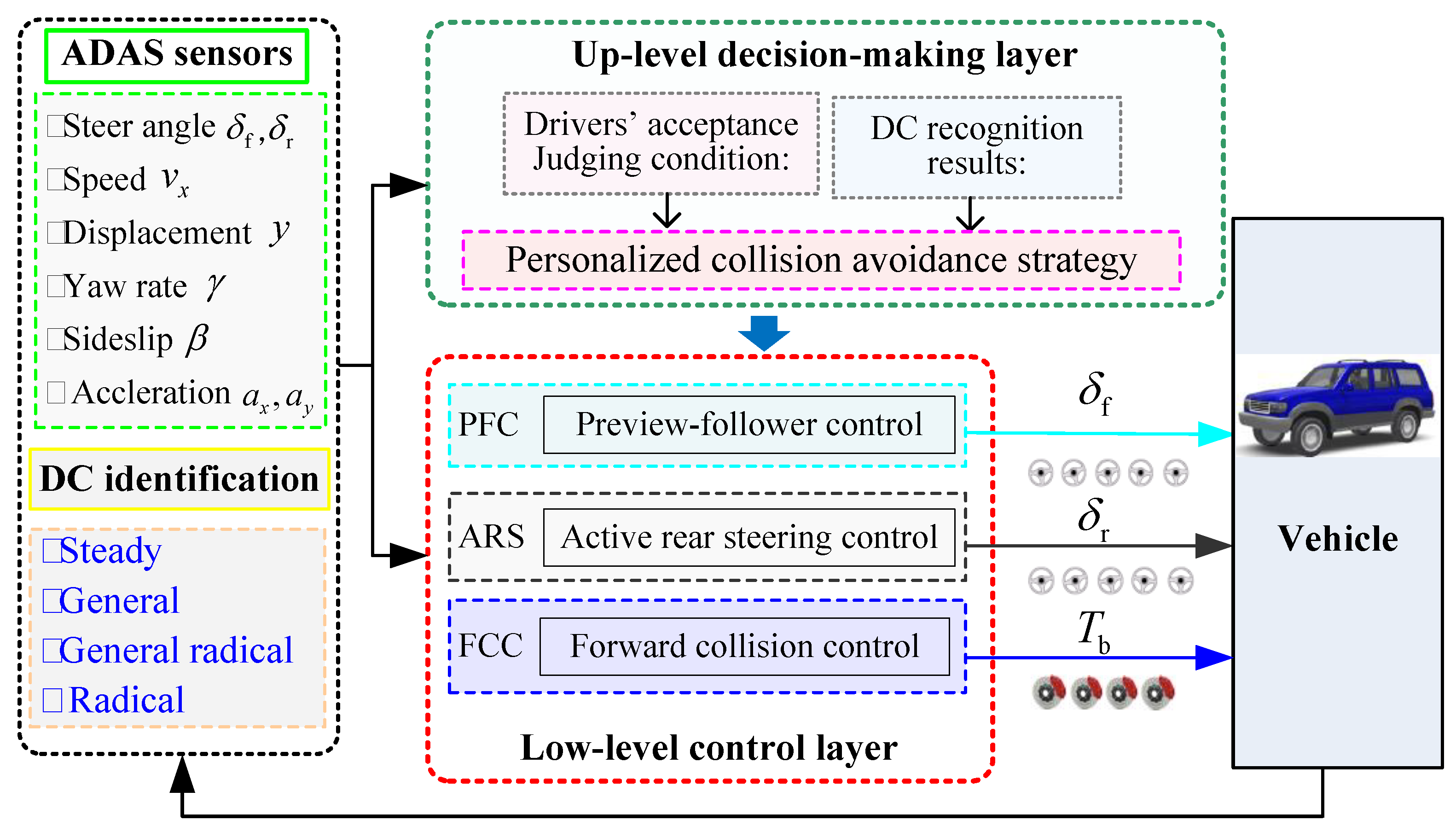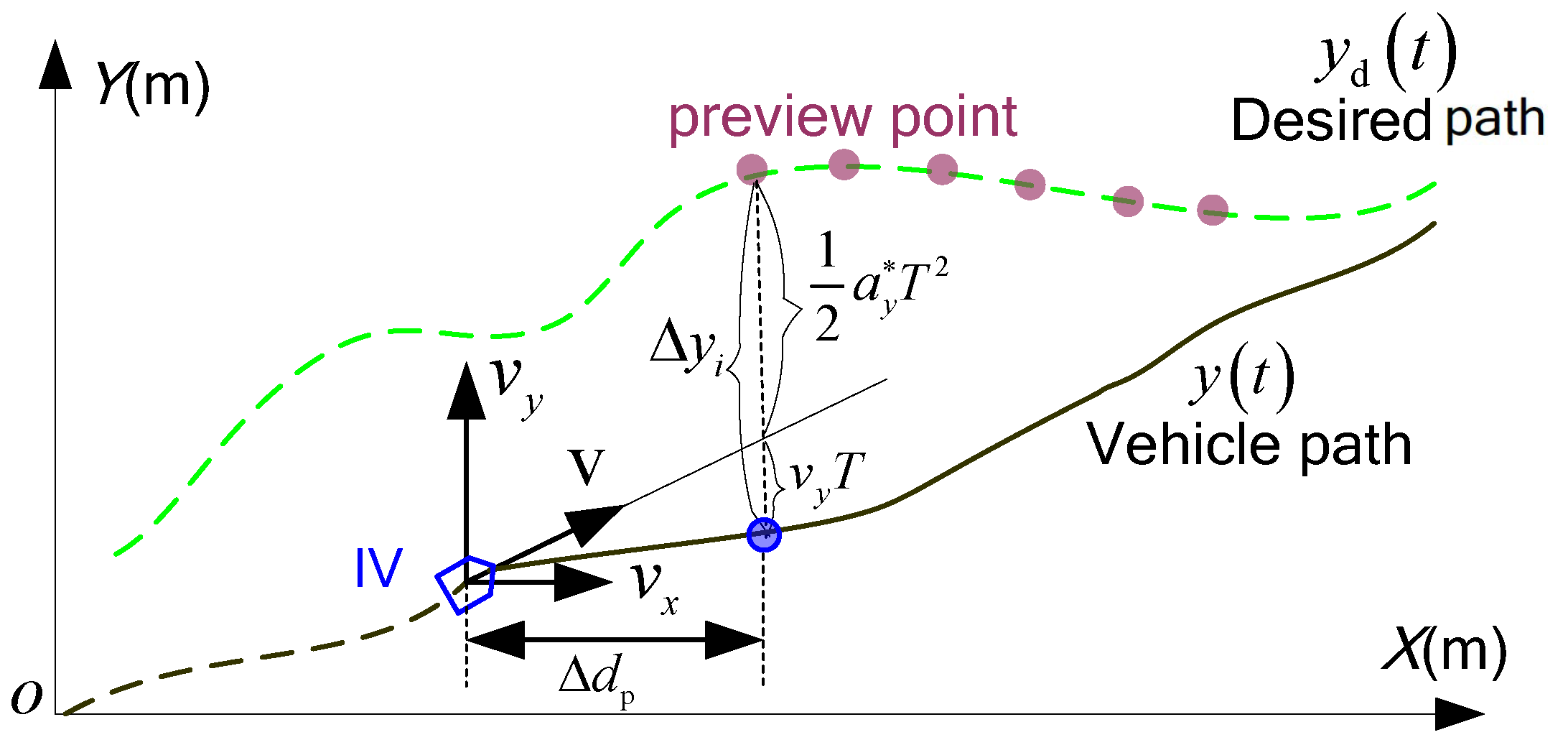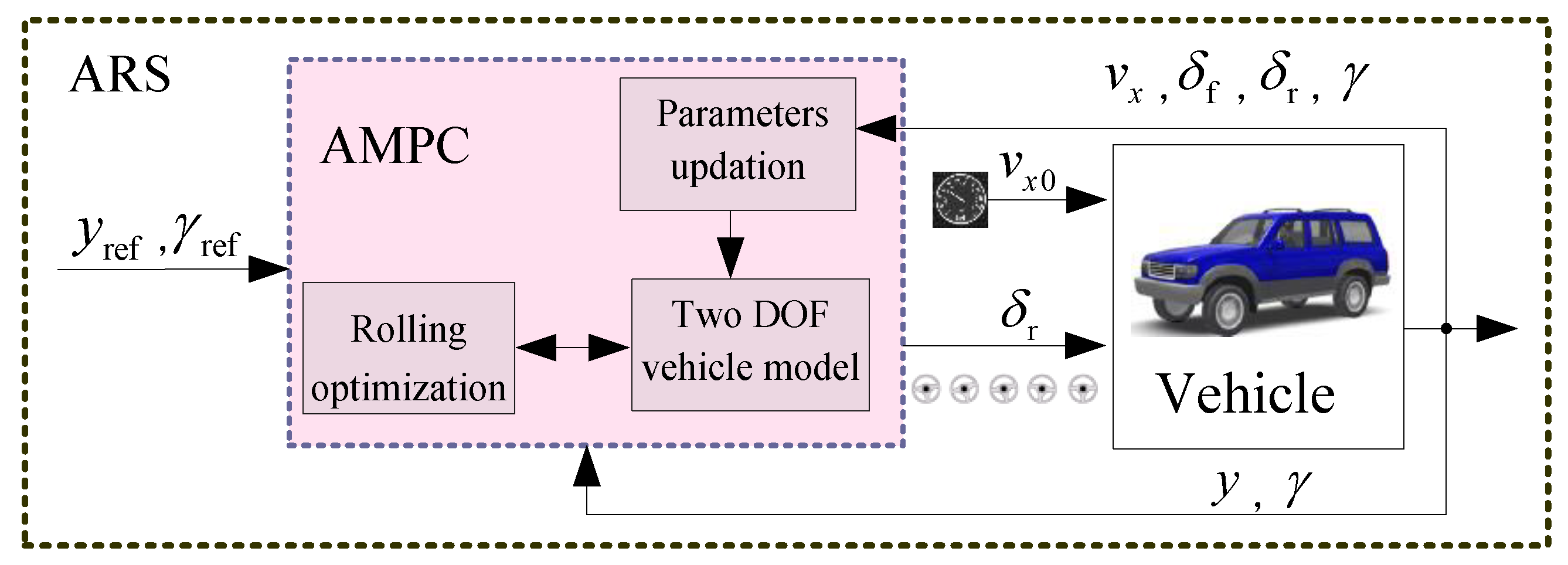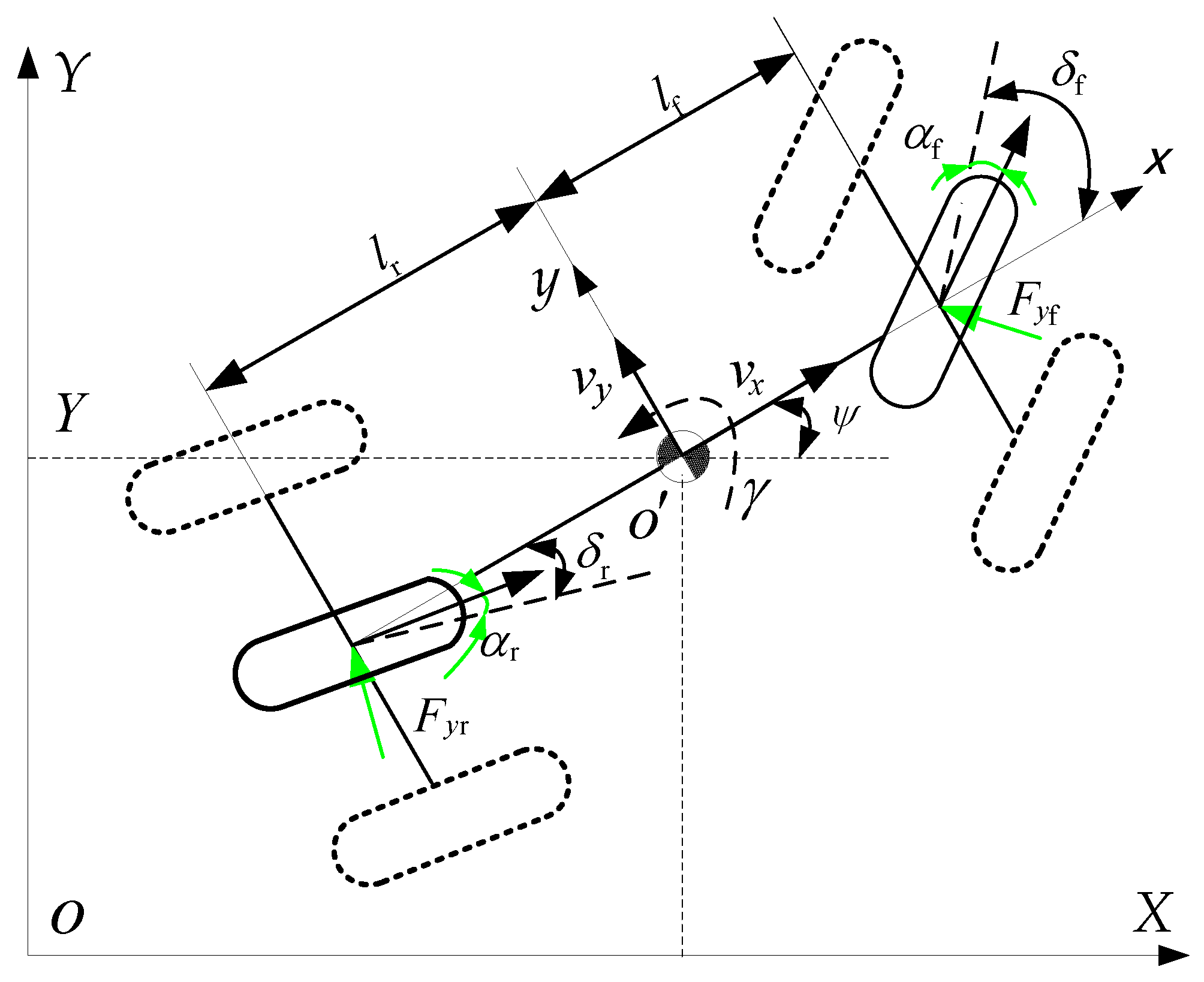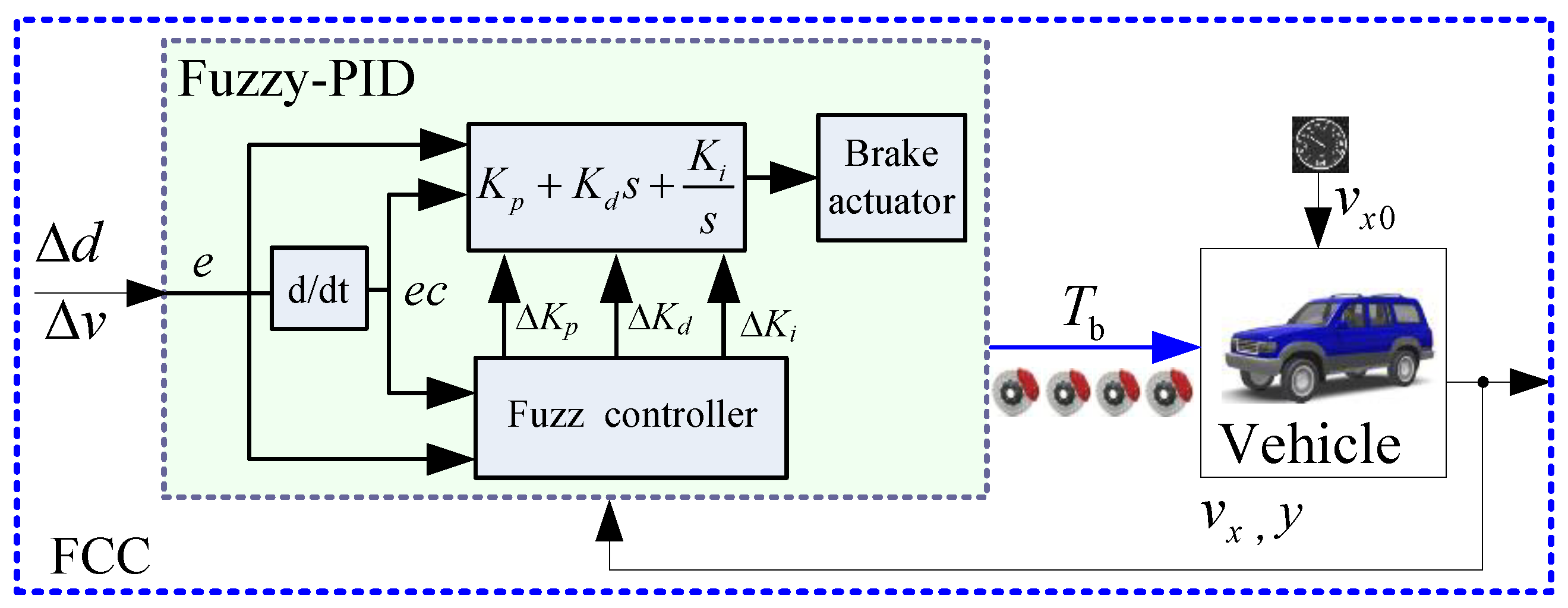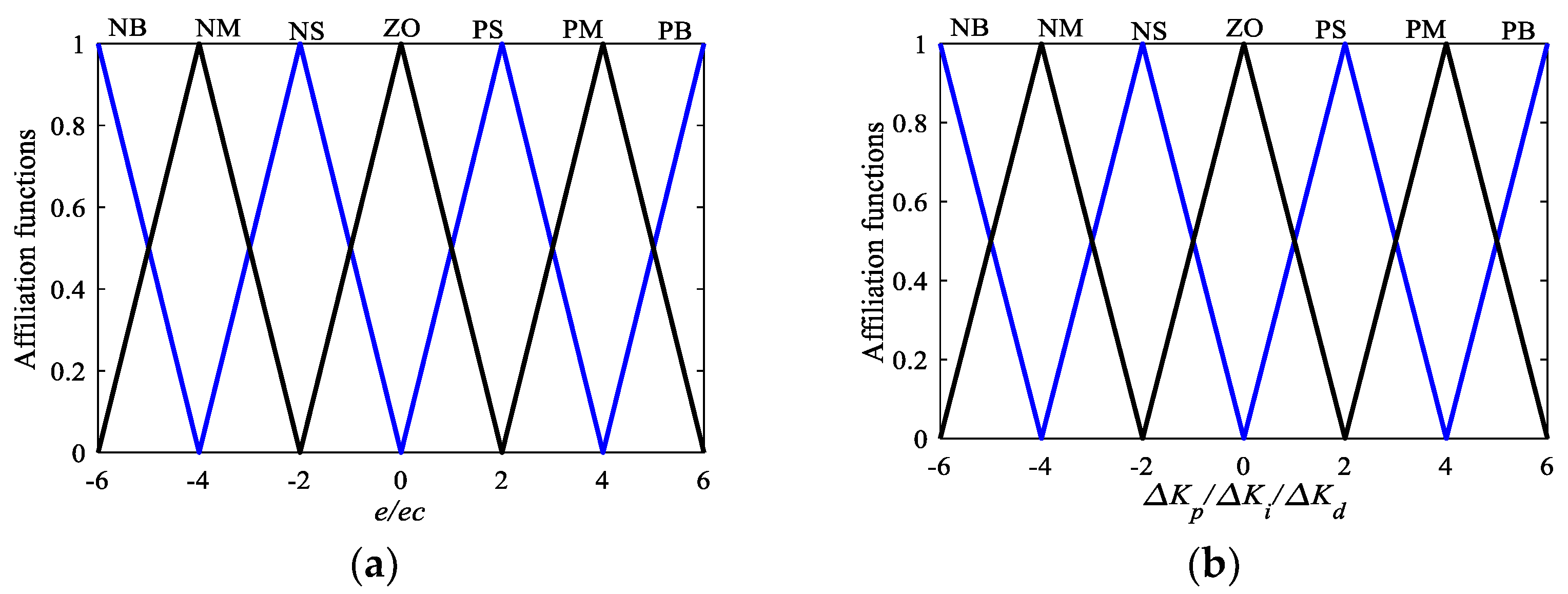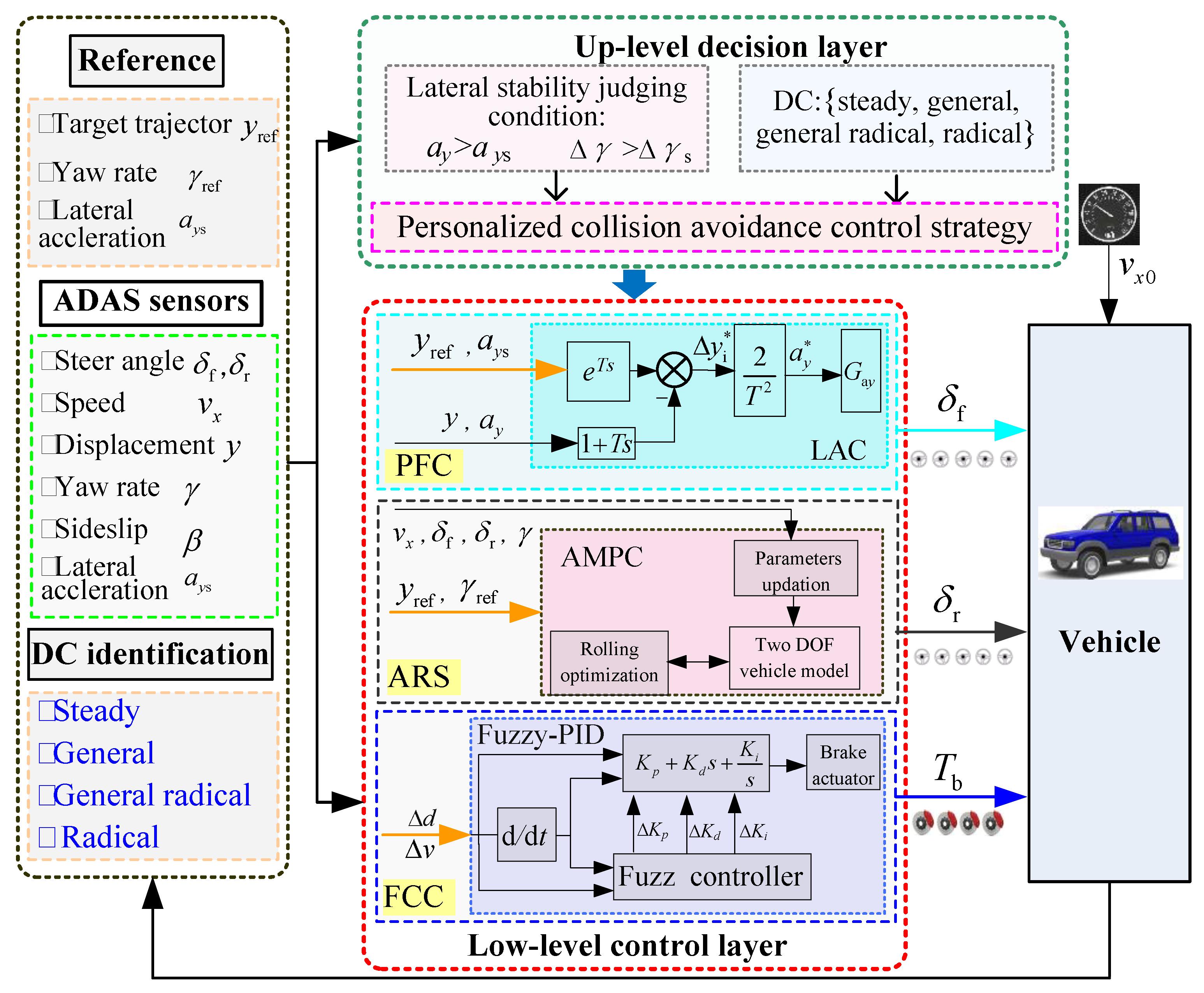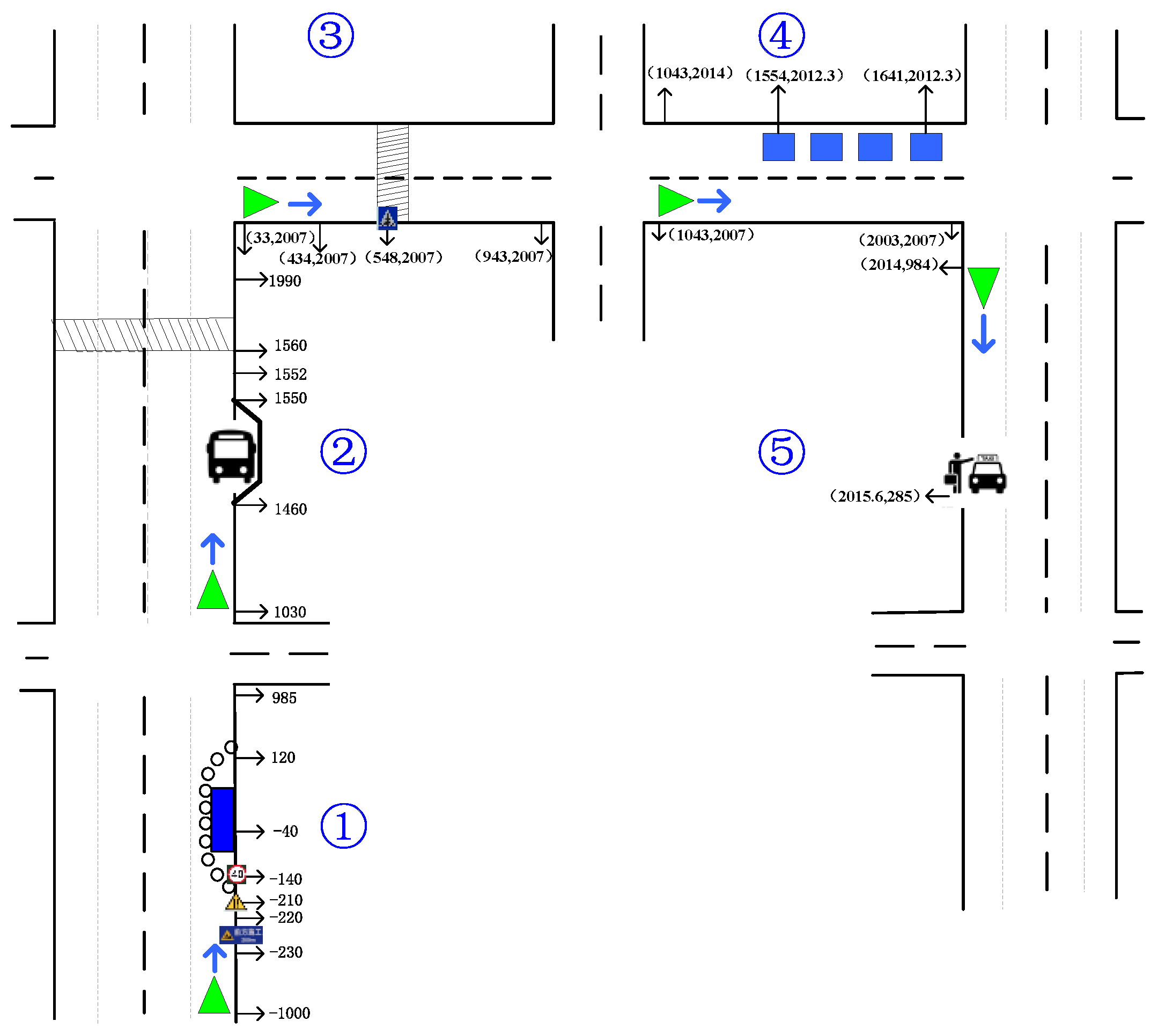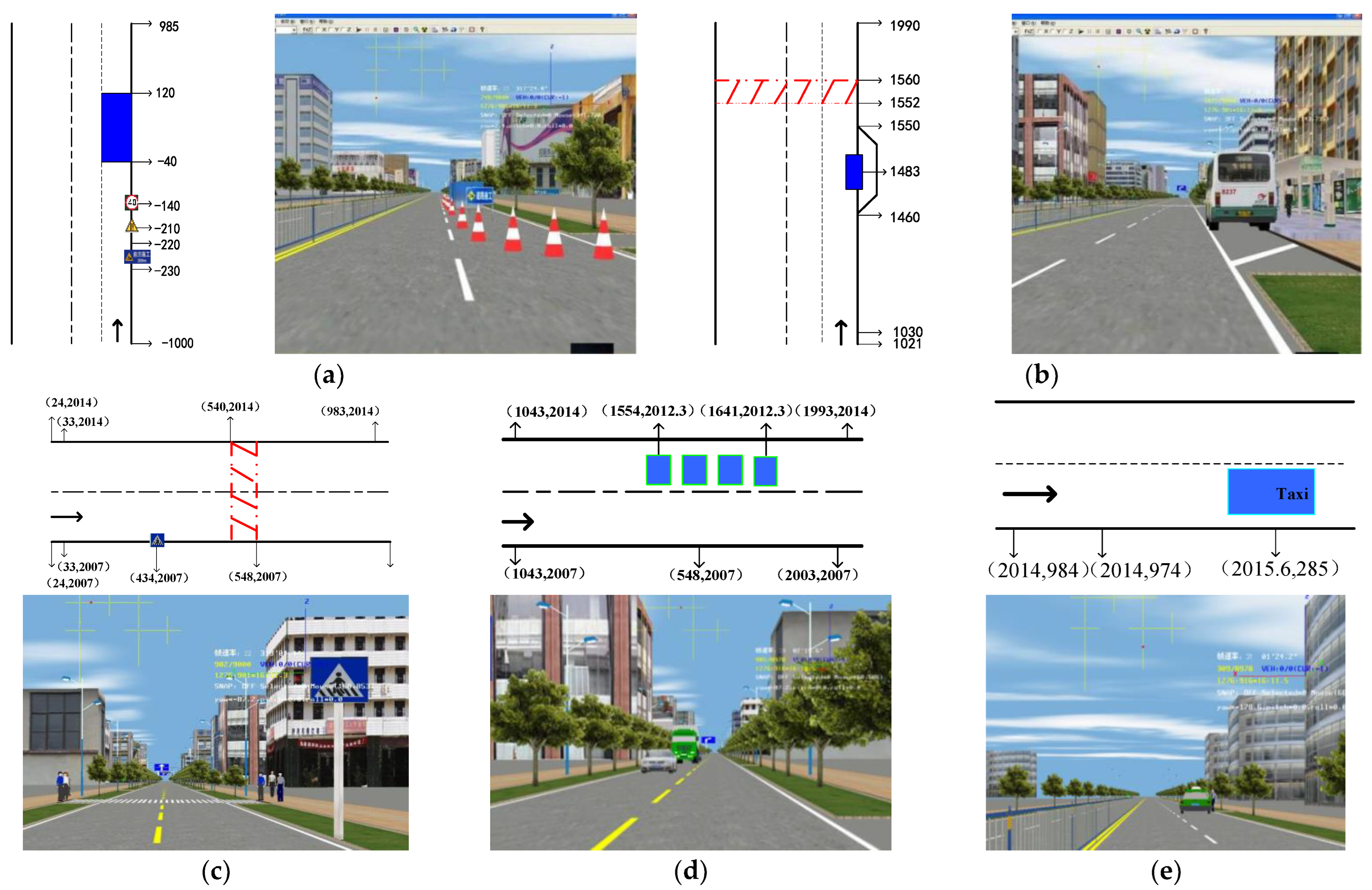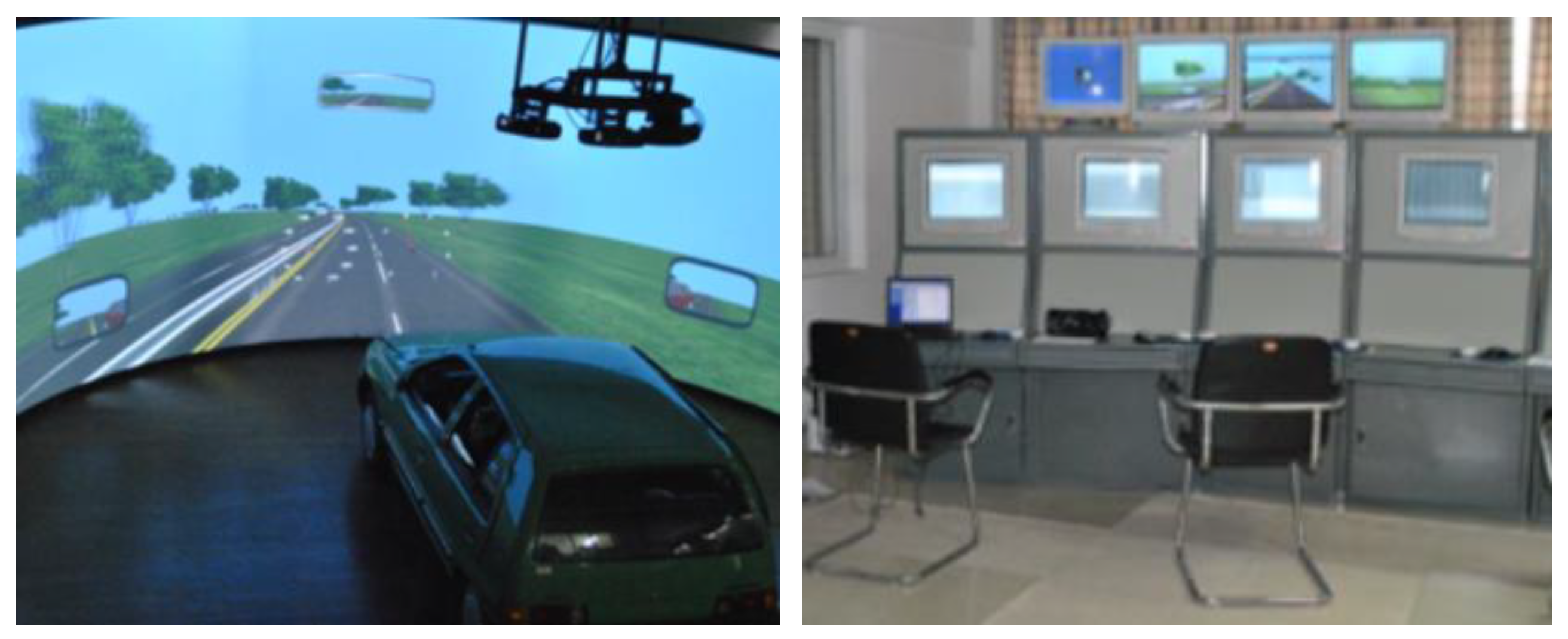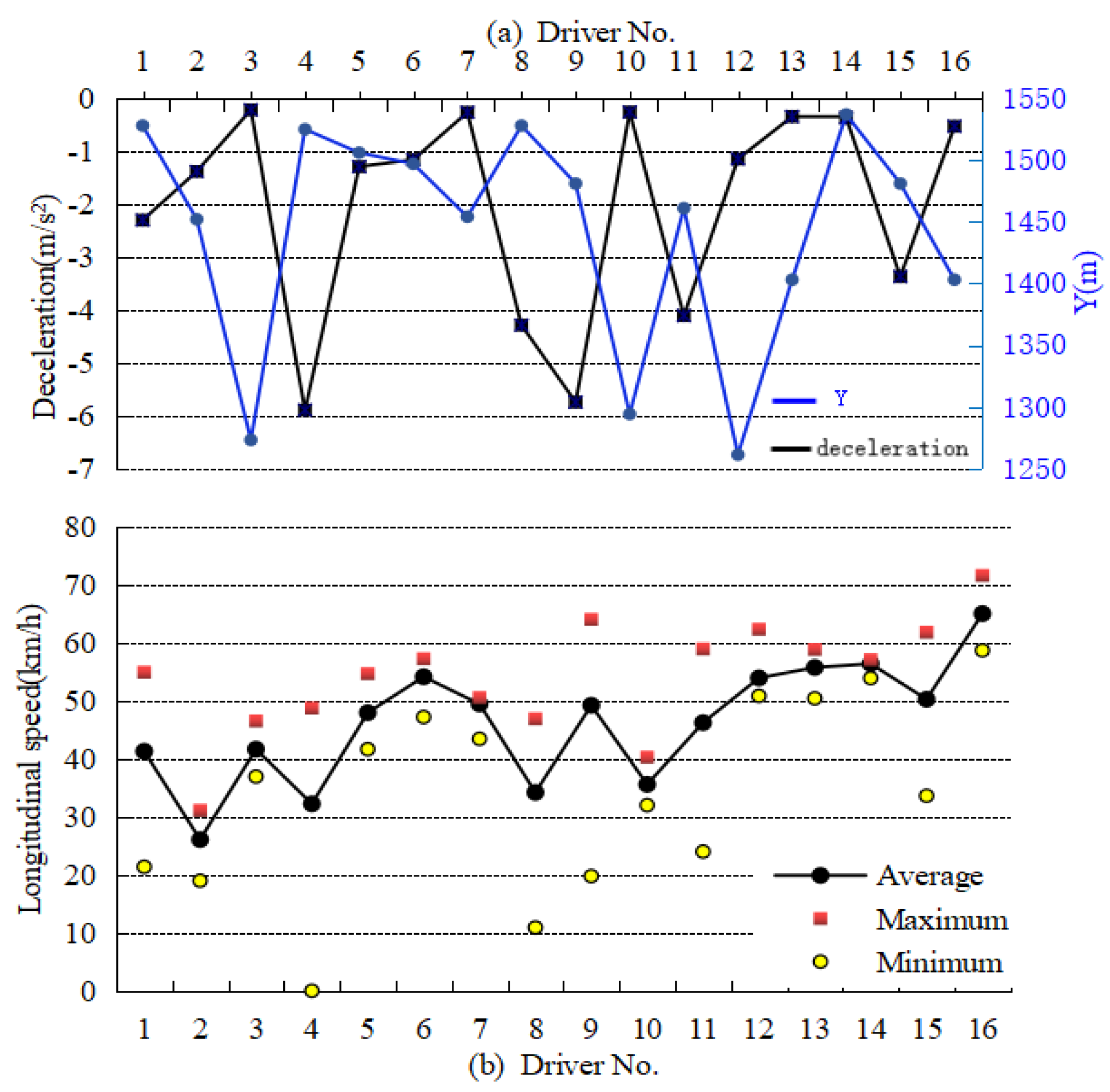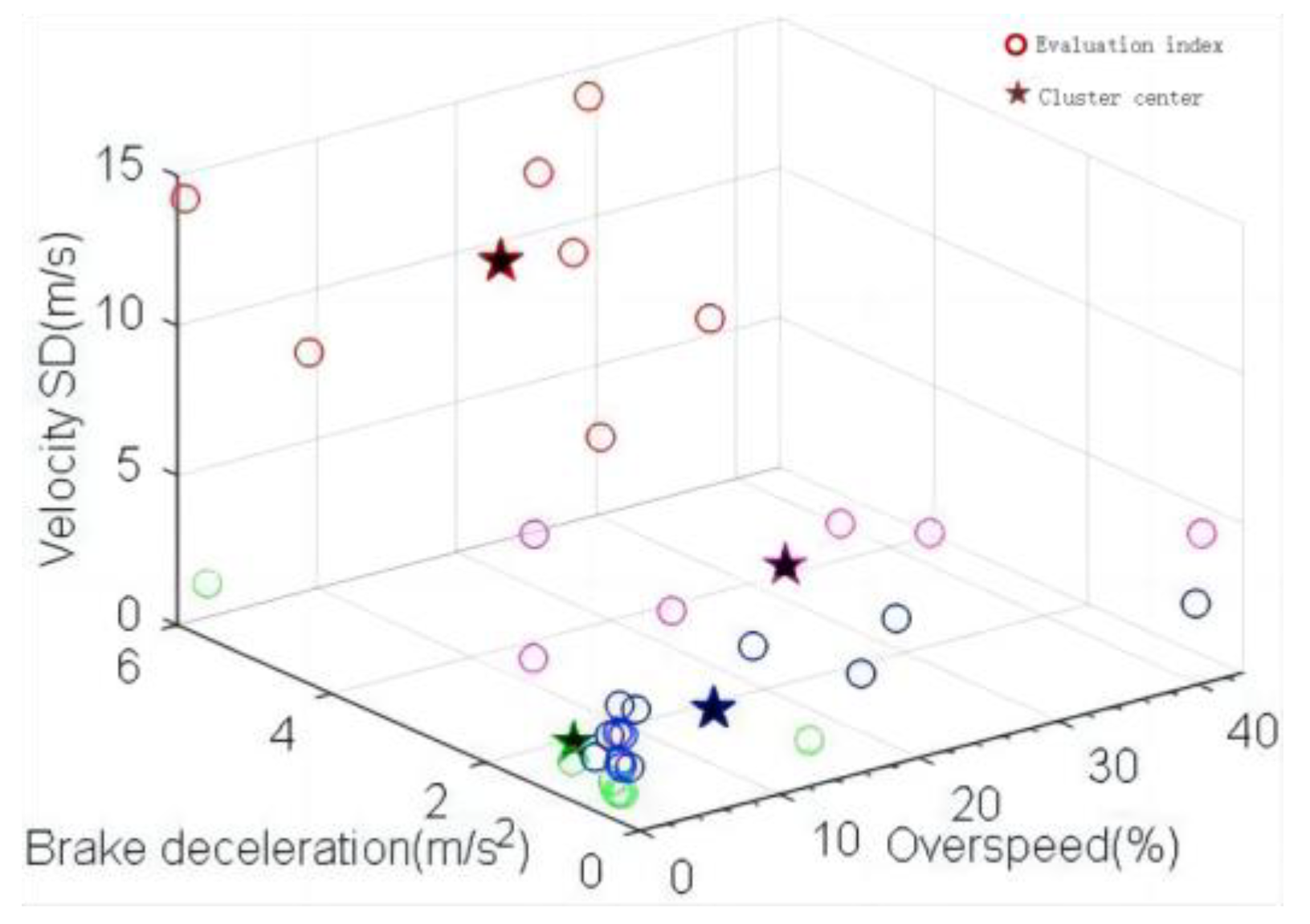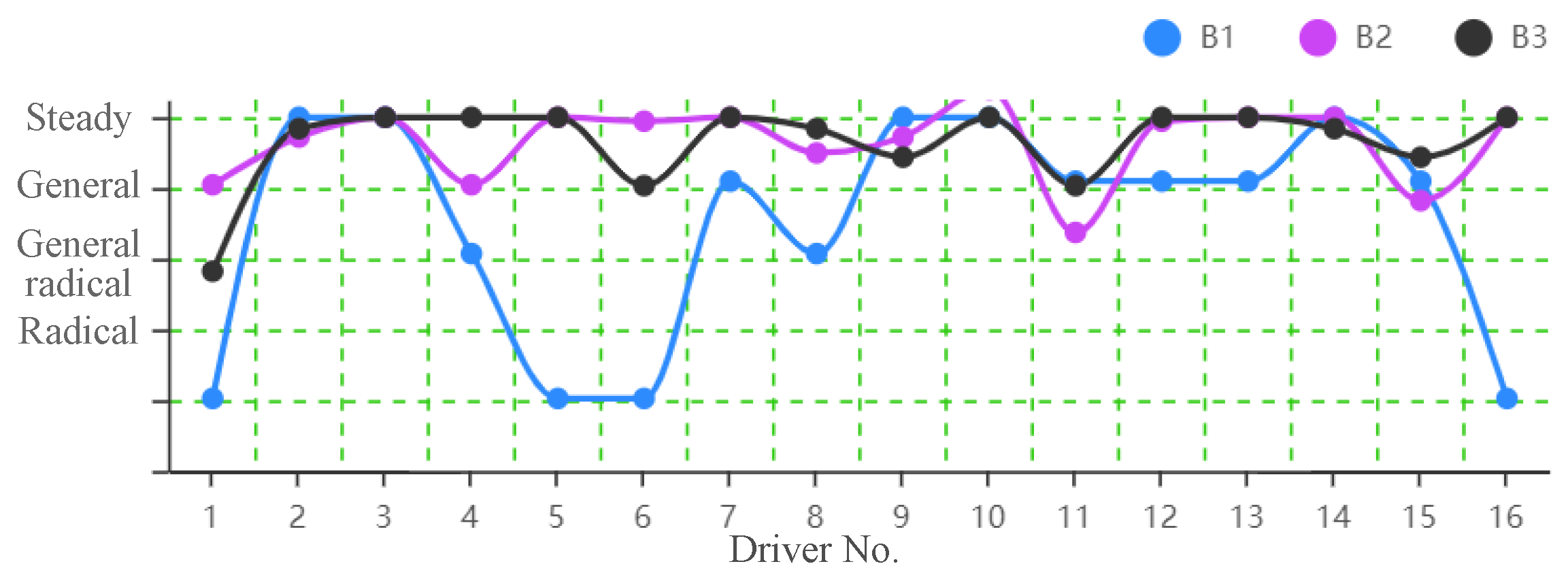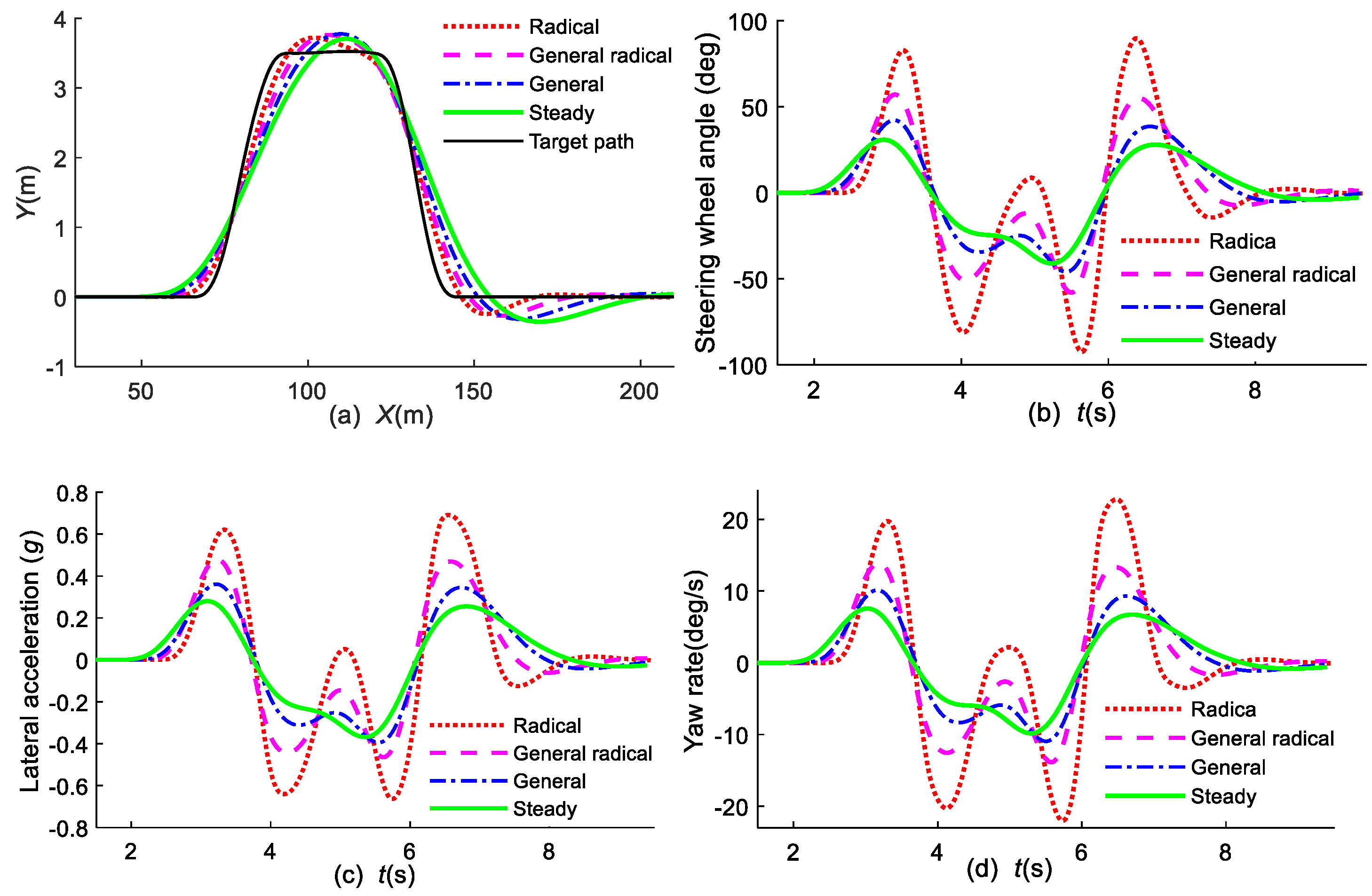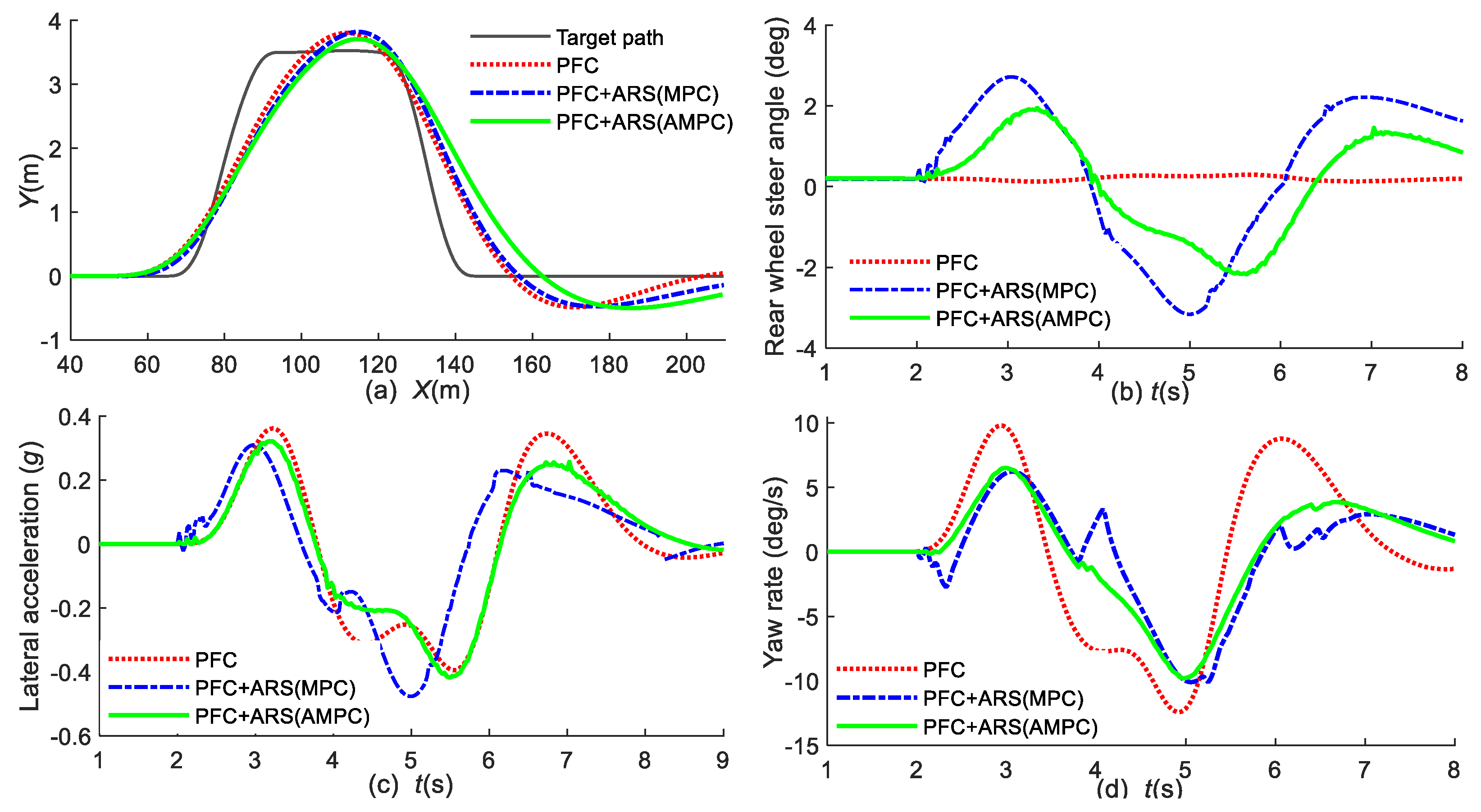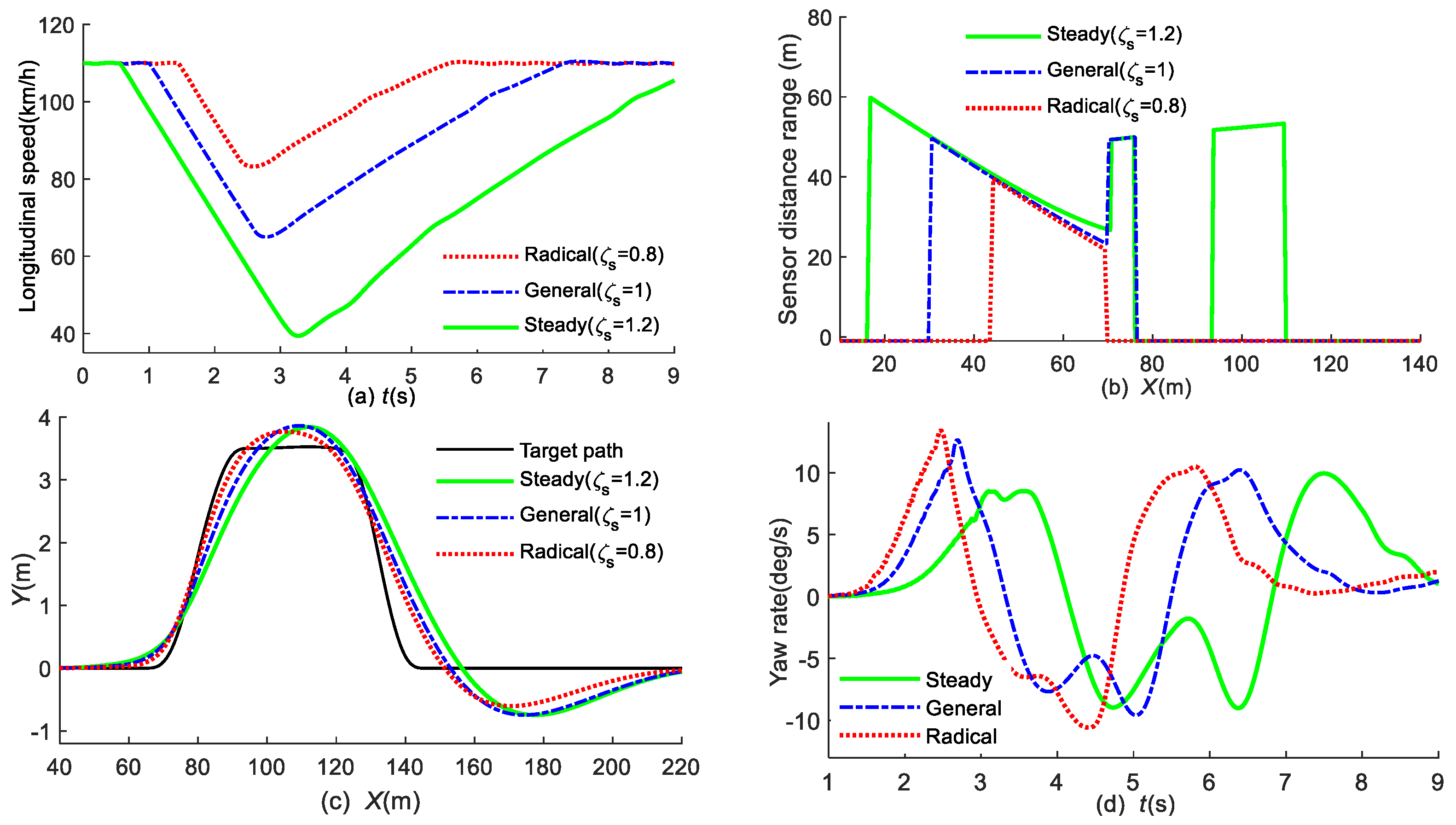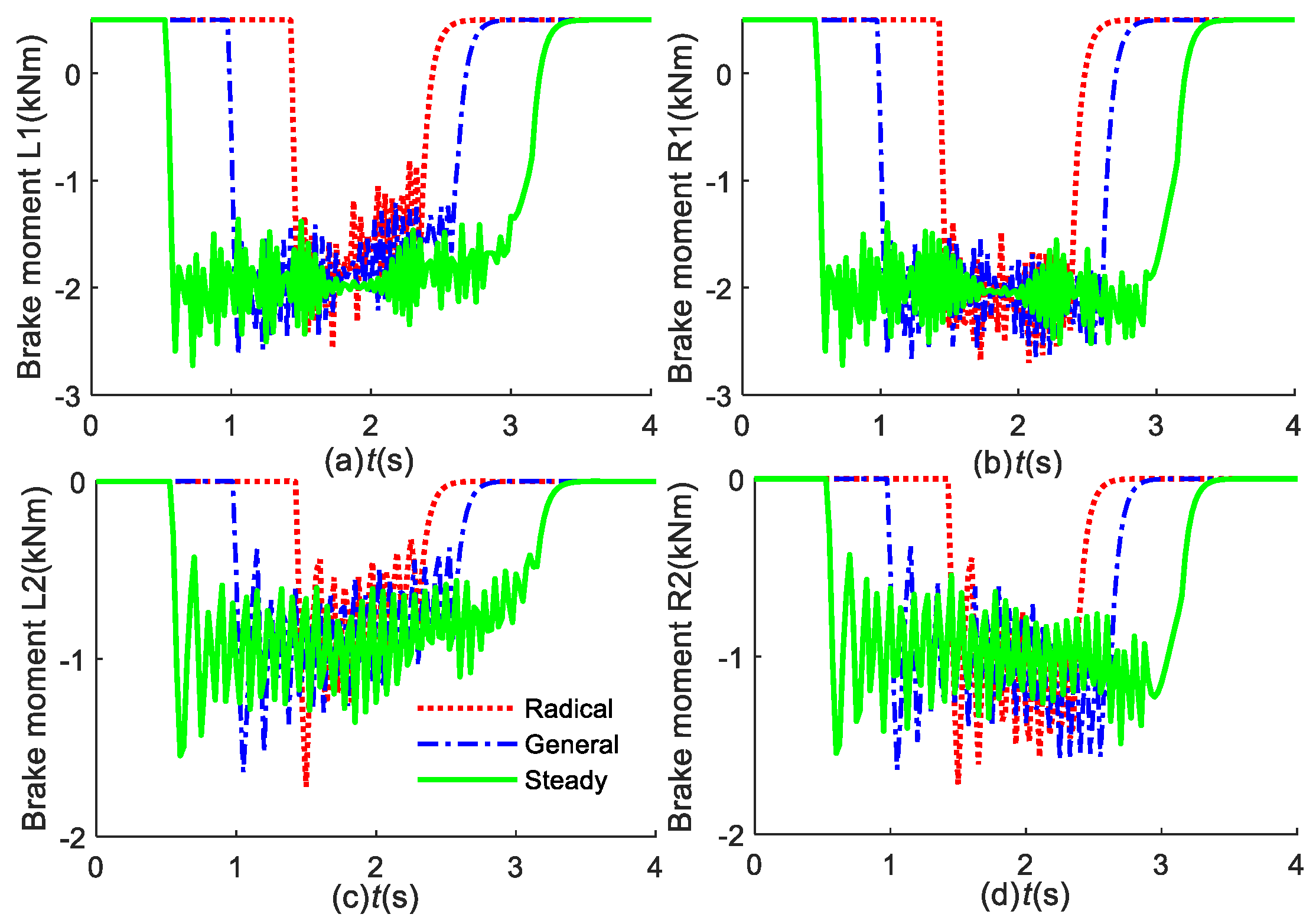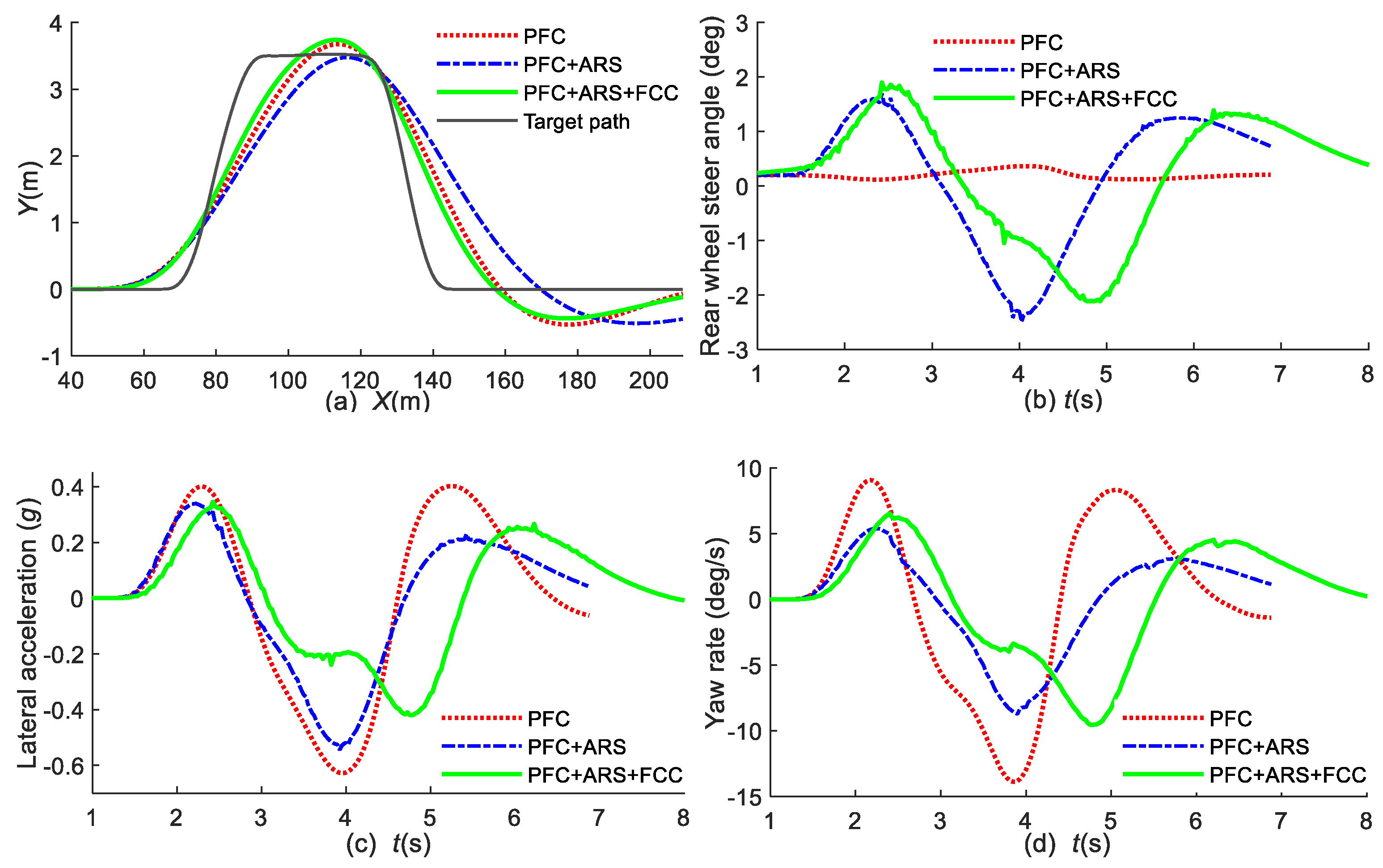1. Introduction
Intelligent vehicles (IV), equipped with advanced driving assistant systems (ADAS), are the best way to improve traffic efficiency, reduce collisions, and achieve self-driving. However, complex traffic situations, unexpected objects, and different driving styles could easily induce crash accidents [
1]. Therefore, collision avoidance is one essential issue in the development of IV. Early collision avoidance strategies, such as active emergency brake (AEB), forward collision warning (FCW), and adaptive cruise control (ACC), are mainly focused on longitudinal control [
2,
3,
4]. It cannot achieve all driving conditions at this stage. Meanwhile, driver and IV will exist simultaneously in the long future. The driving characteristics (DC) of different individuals are an essential factor that affects the performance of collision avoidance controllers (CAC) [
5]. For this reason, the DC is becoming a mainly considered aspect of CAC design.
The study on driving characteristics and self-driving for IV has become even more popular in recent years [
6,
7]. Presently, humans need to intervene timely according to the request of the vehicle decision module for quite some time as IV can only handle some instruction in a specific context. Autonomous collision avoidance faces challenges in complex environments for IV [
8,
9]. The integral design thinking for CAC involves initial path planning followed by precise path tracking [
10]. Claussmann et al. [
11] reviewed the most representative methods for path planning. Yim et al. [
12] discussed the active steering methods for path tracking, such as active front steering (AFS) [
13], four-wheel independent steering (4WIS) [
14], and active rear steering (ARS) [
6]. However, without considering the effects of DC, these methods lack some accuracy.
To further consider the effects of DC, Guo et al. [
15] reviewed and analyzed the application of the driving assistance system and man–machine co-driving cooperation control based on the research results of driving characteristics. Yi et al. [
16] developed a personalized assistance system by observing different drivers performing the same operation at intersections. Zhu et al. [
17] divided the drivers of autonomous vehicles into adaptive drivers and non-adaptive drivers and proved that the traffic capacity improved with the increase in the number of adaptive drivers. Li et al. [
18] established a human-like trajectory-planning method of IV based on a cyclic neural network. Zhu et al. [
19] designed a human-like autonomous car-following model with deep reinforcement learning. Yang et al. [
20] developed an automated highway driving decision considering driver characteristics. Jiang et al. [
21] designed a personalized driver model, including a longitudinal driving behavior model and a lateral lane-change trajectory-planning model by analyzing the driving habits of different drivers. These methods have greatly improved driver adaptability, but they neglect driving safety issues.
When implementing CAC in reality, the driving characteristics cannot be assumed and must be extracted from data. To further identify DC, Wang et al. [
22] used the parameters of time headway, the inverse of the time to the collision to distinguish driver characteristics, and the K-means clustering algorithm to classify driving behavior. Zong et al. [
23] defined a driver characteristics identification model by using the neural network method, and the parameters of steering wheel speed and average velocity are used to characterize driving characteristics. Wang et al. [
24] presented a novel framework for driving style analysis based on a Bayesian non-parametric approach. Zhu et al. [
25] introduced a random forest model to establish a driving style identification strategy according to the hierarchical clustering theory. Zou et al. [
26] employed a support vector machine to identify the driving styles, which is more objective than traditional studies on driving characteristics that are partially subjective and may have issues with calibration accuracy, training sample labels, and identification results. Compared to traditional DC studies, many previous works of machine learning (ML) have been utilized [
27,
28]. Guo et al. [
29] developed a hybrid unsupervised deep learning model for driving behavior recognition. These machine learning techniques presuppose a balanced dataset, but in most cases, the data are imbalanced. Therefore, directly applying these methods may lead to a loss of accuracy.
Motivated by the above discussion, this paper develops a novel PCAC strategy with active security cooperative control. The architecture of the PCAC is comprised of perception sensors together with a decision layer, a control layer, and a chassis actuator. The innovations are summarized as follows:
Unlike the previous work [
26] that only collected DC data under a DLC condition, our study designed five test scenarios for data collection: road construction, the bus station, crossing pedestrians, opposite lane motorcade, and stopped taxi. We adopted K-means clustering to classify DC and used AHP to identify it. The first stage evaluation includes speeding range, brake deceleration, velocity SD, and time ahead of turn signal with varying weightage;
Unlike the works [
6,
12,
13,
14] that design the CAC through pure steering or braking control, this article proposed a PCAC incorporating personalized driver preferences as a key design factor. Specifically, the PCAC is tailored to individual driving habits while ensuring optimal driving stability;
To validate the proposed PCAC based on DC, the PFC model with different DC based on lateral acceleration feedback (LAC), ARS with different DC based on Adaptive model-predictive control (AMPC), and FCC with different DC based on fuzzy PID are respectively designed. Simulation results demonstrate that the proposed PCAC not only effectively avoids collisions but also enhances drivers’ acceptance. Furthermore, the proposed PCAC improves driving stability and acceptance for both steady and general drivers, particularly in high-speed conditions.
The remainder of this paper is organized as follows.
Section 2 designs the driving characteristics identification method. The structure of the PCAC is designed in
Section 3. Simulations based on the driving simulator and CarSim software are shown in
Section 4.
Section 5 presents the conclusions.
5. Conclusions
The designed novel personalized collision avoidance control (PCAC) strategy for intelligent vehicles (IV) based on driving characteristics (DC) can not only improve driving stability but also improve driver adaptability. The PCAC consists of a decision part and a control part. Specifically, the CAC is integrated with preview-follower control (PFC), active rear steering (ARS), and forward collision control (FCC). As a result, we came to the following conclusions:
The DC of 16 drivers can be classified into four types: steady, general, general radical, and radical. The analytic hierarchy process (AHP) can be used to recognize the DC accurately.
The PFC model with different DC based on lateral acceleration feedback (LAC) shows that the evaluation indexes are smaller, more stable, and steering earlier by steady and general drivers compared with radical drivers, which can meet individual requirements.
For steady and general drivers, the acceptance of the PCAC by PFC remains inadequate due to lateral acceleration surpassing its threshold. However, when combined with PFC+ARS, PCAC demonstrates an 11% reduction in lateral acceleration compared to PFC alone. Additionally, the peak value reduction of the yaw rate exceeds 30%.
The PCAC integrated with PFC, ARS, and FCC significantly reduces lateral acceleration and yaw rate, resulting in an improved acceptance index of over 30% compared to the PCAC with only PFC. This proposed system effectively enhances driving stability and acceptance for both steady and general drivers, particularly in high-speed obstacle-avoidance scenarios.
Future work will focus on drivers’ DC recolonization based on deep reinforcement learning (DRL).
